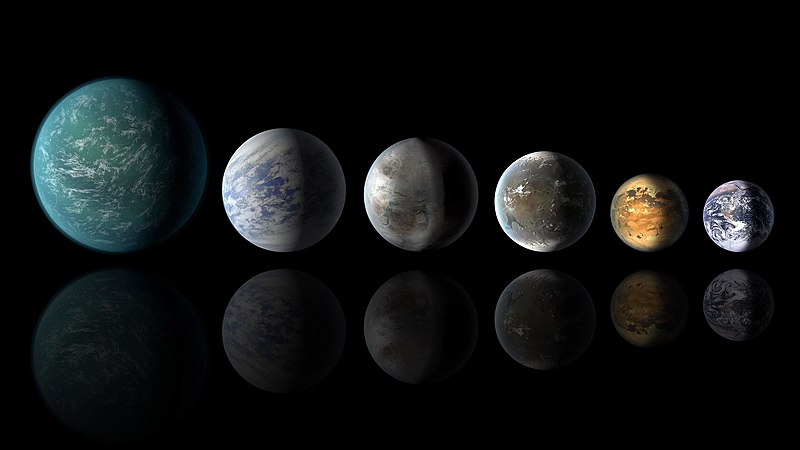Facts for Kids
Exoplanets are planets that exist outside our Solar System, orbiting other stars, with diverse sizes and conditions.
Overview
Detection Methods
Types Of Exoplanets
What Are Exoplanets
Habitability Criteria
Future Research In Exoplanets
Notable Exoplanet Discoveries
Challenges In Studying Exoplanets
Exoplanets And The Search For Life
The Role Of Telescopes In Exoplanet Exploration

Inside this Article
James Webb Space Telescope
Proxima Centauri B
Information
Atmosphere
Velocity
Universe
Jupiter
Methane
Earth
Light
Did you know?
🌌 There are over 5,000 known exoplanets orbiting stars outside our Solar System.
⭐ Some scientists believe there could be billions more exoplanets yet to be discovered!
🪐 Exoplanets can be smaller than Earth or larger than Jupiter!
🌠 The first exoplanet was discovered in 1992.
🏞️ Some exoplanets are very close to their stars, making them too hot for life.
🌈 Exoplanets come in many shapes and sizes, including rocky and gas giants.
🪐 'Super-Earths' are larger than Earth but smaller than Neptune.
🌊 The 'habitable zone' is where liquid water could exist on an exoplanet.
🔍 Kepler-186f is a notable exoplanet around the same size as Earth in a habitable zone.
🌌 Scientists use telescopes like Kepler and TESS to discover new exoplanets.
Introduction
Well, there are! They're called exoplanets, which are planets located outside our Solar System. There are over 5,000 known exoplanets orbiting stars far, far away. ⭐
Some scientists think there could be billions more waiting to be discovered! Exoplanets can vary in size, from smaller than Earth to gigantic gas giants bigger than Jupiter! Each one has its own story, and studying them helps us understand our universe better. 🪐
Detection Methods
There are a few cool methods! One popular method is the "transit method." When a planet passes in front of its star, it causes a tiny dip in light. 📉
Scientists measure this change using powerful telescopes. Another method is the "radial velocity method," which detects wobbles in a star caused by a planet's gravity. 🌍
Telescopes like Kepler and TESS look at thousands of stars at once, helping us discover new exoplanets every day!
Types Of Exoplanets
Some are rocky like Earth and are called terrestrial exoplanets. Others are massive gas giants like Jupiter and are often much larger. There are also "super-Earths," which are bigger than Earth but smaller than Neptune. 🪐
Some exoplanets exist in the "habitable zone," the perfect spot where liquid water could exist. Scientists are excited about these because they might have the right conditions for life! 🌊
What Are Exoplanets?
They orbit a star just like Earth orbits the Sun. The first exoplanet was discovered in 1992, and since then, thousands have been found! Some are very close to their stars, making them too hot for life, while others are further away, where conditions could be just right! 🏞
️ Scientists study exoplanets to learn about how different worlds can be and see if any might support life.
Habitability Criteria
Scientists look for several criteria! First, a planet needs to be in the habitable zone of its star, where temperatures are just right for liquid water to exist. ☔
️ Next, it should have a solid surface and an atmosphere that can protect it from harmful radiation. 🌪
️ Other factors, like enough light from its star and the presence of organic materials, are also crucial. Finding these planets is super exciting because they might host life as we know it!
Future Research In Exoplanets
️ Scientists are building new and improved telescopes to discover even more exoplanets. One exciting upcoming telescope is the James Webb Space Telescope, which will help us look for clues about atmospheres and potential signs of life! 🔭
Researchers are also studying atmospheres of known exoplanets to learn about their weather and climates. 🌀
Each discovery brings us closer to figuring out whether we're alone in the universe or if there are other life forms out there!
Notable Exoplanet Discoveries
One famous exoplanet is Kepler-186f, discovered by the Kepler Space Telescope. It's about the same size as Earth and is located in a habitable zone! 🌍
Another exciting find is Proxima Centauri b, which is just 4.2 light-years away! It's the closest known exoplanet to us! 🛸
Scientists keep searching for more amazing planets to learn about, and each discovery brings us closer to understanding the cosmos.
Challenges In Studying Exoplanets
One challenge is that they are incredibly far away, sometimes hundreds or thousands of light-years away from us! 🌌
This distance makes it difficult to gather clear information about them. Also, exoplanets can be very faint compared to their bright stars, so scientists need advanced technology to spot them. ⏰
Plus, with so many different types of exoplanets, each one can present unique challenges in studying its atmosphere and conditions. But scientists love solving puzzles, so they keep pushing forward! 🧑
🚀
Exoplanets And The Search For Life
They use special tools to search for signs of life, like detecting gases such as oxygen and methane in a planet’s atmosphere. 🌬
️ Some scientists believe that if we find planets with these gases, it could mean that life exists there. They also study Earth-like conditions on other planets to better understand what alien life might need to survive. 👽
The search for life beyond our planet is exciting and full of endless possibilities!
The Role Of Telescopes In Exoplanet Exploration
They help scientists observe stars and exoplanets from Earth or space. Special telescopes, like Hubble and Kepler, can capture images and measure light from stars to find exoplanets. The new James Webb telescope will be even more powerful, allowing scientists to study exoplanet atmospheres in great detail. 🌠
Telescopes help us gather valuable data and expand our knowledge of the universe and its many secrets!

